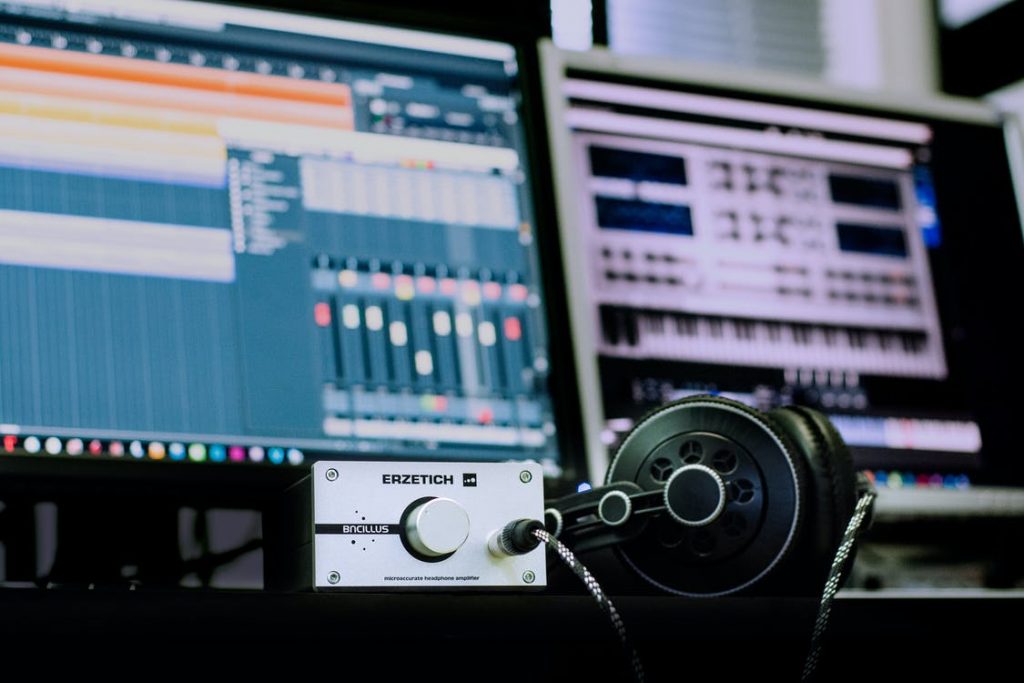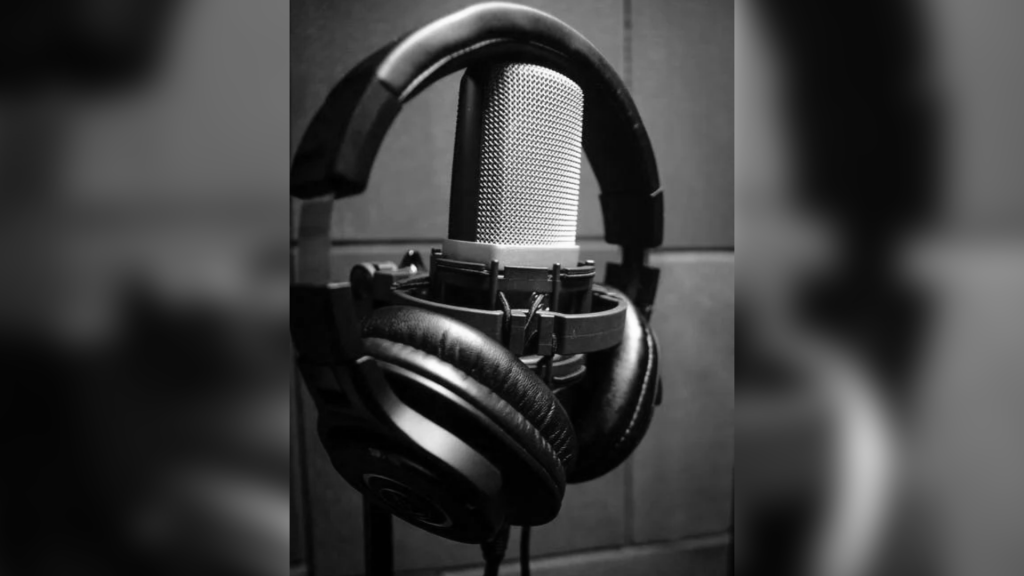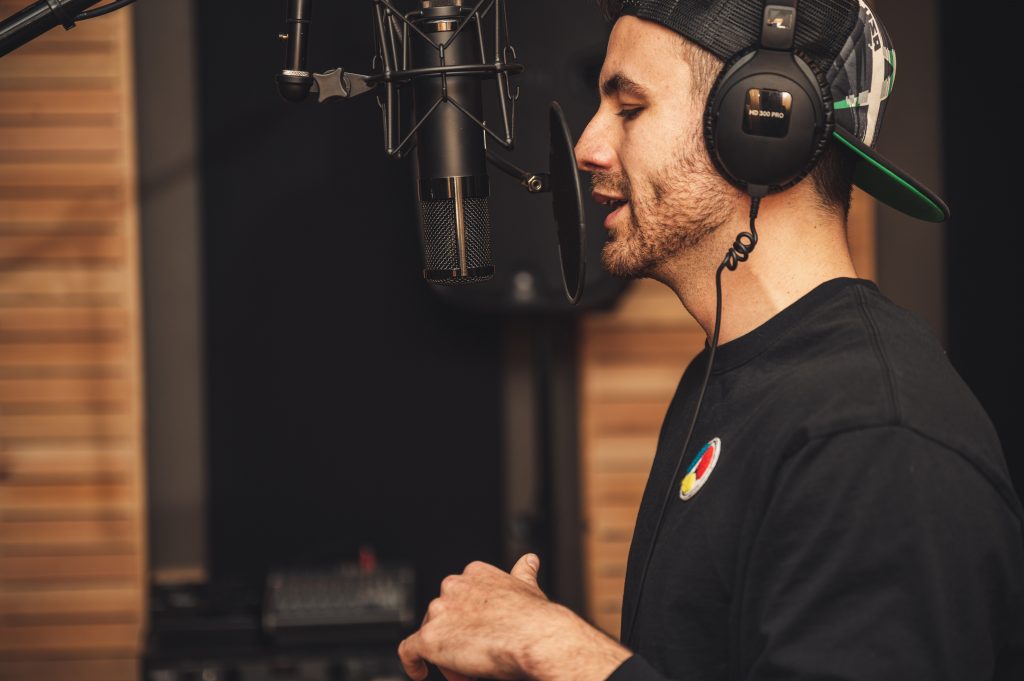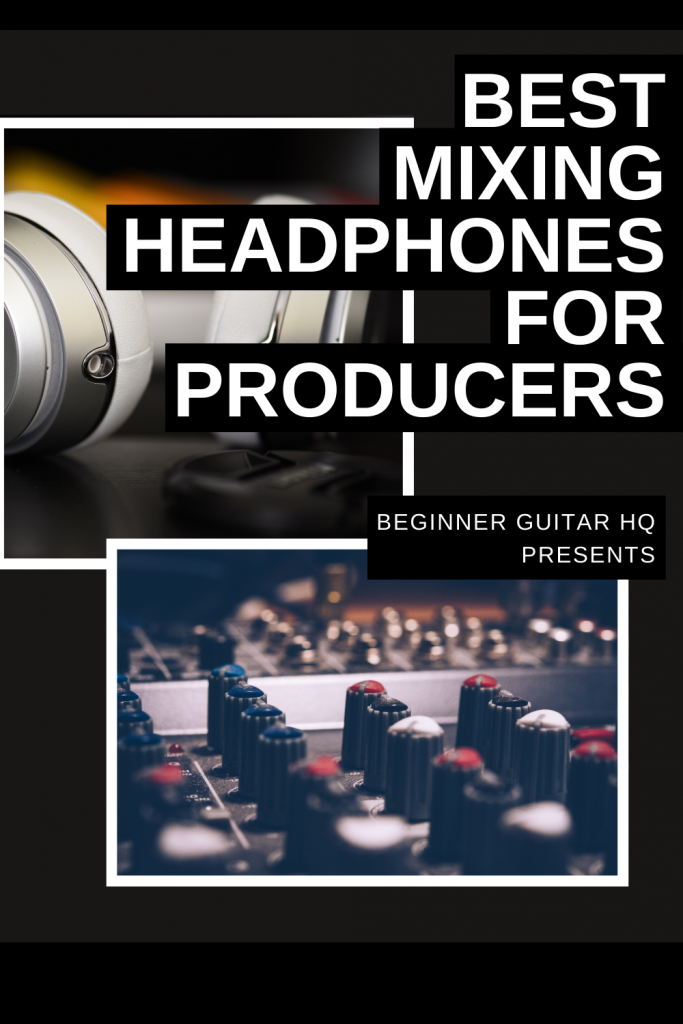Headphones are but one aspect of music production that should not be cheaped out on. In fact, listening to your mix from a pair of open-back headphones, compared to a pair of closed-back might change your perspective completely on how accurate your headphones really are. Here you’ll learn more about what headphones are right for you!
Contents
The Optimal Headphones for Mixing
When you’re in the process of mixing, it’s highly recommended that you do so with a pair of open-back headphones. Headphones of this type are fantastic for audiophiles alike, as it gives a very close representation of what you’re actually listening to. For instance, there are other headphones that may “exaggerate” specific frequencies, whether they be high-end or low-end, based on their design. When you’re mixing, you want to hear the real thing, or as close as you can get, so that not only will you mix with accuracy, but that you do so with the intention of the mix sounding good from multiple playback sources.
For bedroom producers, ones that may not particularly have an expensive setup, headphones are great, and often a cost-effective means of getting to hear your work. Open-back studio headphones are something that may cost a little more than a standard pair of Bluetooth, noise-canceling, or closed-back headphones. However, if you want to take a single step towards improving your mix, open-back headphones are often worth paying a little extra for.
The Studio Standard

It’s normal for music producers to have their studio space equipped with a nice pair of studio monitors. Studio monitors, or stereo speakers, receive a stereo signal, important for most modern music that you hear today. Contrary to a mono signal, you receive sound from two sources – a left monitor and a right monitor, giving modern mixes the enhanced element of space. This is where production elements such as panning, delay, and phase cancellation can add some fullness and depth to your mix.
The main reason that music producers will prefer studio monitors has to do with their flat frequency response. Flat frequency response refers to the frequencies upon playback being heard at equal levels. Typically you’ll want that if you want to hear an accurate representation of your mix. There are some open-back headphones capable of getting fairly close to attaining this frequency response, however, a pair of studio monitors will often do it better.
Studio monitors are great, but the main drawback to studio monitors, however, isn’t only in the cost of the monitors themselves, but in the space, in which they’re being used. You can get a super expensive pair of studio monitors, but if your studio space isn’t acoustically treated, then you won’t get the sound you’re paying for. It’s important to equip your studio space with bass traps, acoustic paneling, and diffusers.
You may decide, based on whether it’s your financial situation, living conditions, or how seriously you take your music production that headphones are better for you. They’re not only portable and cost-effective, but with them, you can enjoy a nice listening experience without disturbing others.
Factors to Consider When Buying Headphones

It’s essential for bedroom producers, and people who cannot afford a proper studio setup to invest in the right pair of headphones for music production. There are many factors to consider that can change, and overall enhance your experience to make sure that your job is done more easily and efficiently.
Your Budget
How much are you willing to spend? This may also tie into how seriously you take music production, if it’s something that’s more of a hobby, or something that you’re truly passionate about and wish to make a living from.
Durability
This factor can easily tie into the aforementioned one, in other words, “you get what you pay for”. Will the headphones hold up when you’re travelling? How durable is the cord? Will I be running over it with my computer chair by accident? Will I forget I’m wearing it and accidentally walk away ripping out the jack? You’ll also want to factor in sweat, as moisture and electronics don’t mix well together. This can damage electronic components when any water or moisture seeps through the headphones. It’s always important to remember, that even a cheap pair of headphones can come with a hefty price. You’re always sacrificing something in addition to a lower pricetag.
Get Firsthand Experience
Always take reviews with a grain of salt before buying, as most of what you hear are subjective opinions and down to preference. If you know someone with a nice pair of headphones you are interested in, they can be a great source for trying them out firsthand. Otherwise, you can try different pairs out at the store. Ultimately, you want to make sure that they are a right fit for you.
Portability
Are the headphones great for travel? Will they get banged up, and damaged easily? Are they bulky, or more compact? Is the cable long or short? These are important things to factor in, if you’re on the go, perhaps collaborating with other artists and producers, you want to be able to efficiently get your hardware from point A to point B with ease.
Feeling
If you’re going to wear these headphones for hours on end, they should at least feel somewhat comfortable. Over time, it will become more difficult for you to focus on your project if you’re worried about your aching head and ears.
Primary Use
What are you going to be using these headphones for? If you’re looking to mix, you may prefer to use a pair of open-back headphones. If you’re looking to monitor, you may rather closed-back headphones. These all factor into your auditory experience.
Best Headphones for Music Producers
There are many great headphone manufacturers like Sennheiser, Audio-Technica, Sony and Beyerdynamic that have the complete package in terms of sound quality, comfort and portability. In no particular order, here are a few different models that we recommend for music production:
Sennheiser HD 280 PRO
For those that can appreciate a nice physical aesthetic, you’re in luck, as this closed-back pair of headphones is something of a “remaster” of the widely-popular HD 280 PRO. Not only in its sleeker look, but in the overall experience of using it, users can experience its improved comfort, and sound quality. For a set of closed-back headphones, you may notice that it has a fairly flat-frequency response, making most of what you hear sound reasonably accurate. Another handy feature it contains is the ability to block out ambient noise, tailored for your studio environment. This is nice if you have fans going, people in another room, traffic outside…etc.
For users looking for more low-end frequency response, this pair of headphones may disappoint you. Compared to other closed-back headphones out there, its a little underwhelming in that regard, in which, you’ll likely need to tweak it. Otherwise, this set of headphones are top notch, for a fairly low price as far as headphones go.
Sennheiser HD 800 S
This pair of open-back headphones are a great pair for mixing, as it has a stellar mid-range performance, and allows vocals and instruments to shine prominently. While it does lack on lower-range frequencies, the treble contains some bright and powerful qualities that some might find desirable. If you’re a new and aspiring producer, this may not be the headset for you, or at least not yet. It’s very expensive, however, as far as quality goes, it provides a lot of bang for your buck.
Audio Technica ATH-M50x
A very well received pair of closed-back headphones, the Audio Technica ATH-M50x make recording a more enjoyable task, providing comfort, and given their closed-back design, prevent sound-leakage fairly well. This is to say, it does not prevent audio from leaking entirely, as higher frequencies have a tendency to leak from the headphones.
It comes at a pretty affordable price, however, it’s still recommended that for the mixing stage, you will want to use a pair of closed-back headphones. The Audio Technica ATH-M50x aren’t a terrible pair of headphones for the mixing process, but when you need to have the utmost accuracy and to hear an accurate representation of your mix, they fall short. It’s recommended that this pair of headphones be used for lengthy recording sessions.
Beyerdynamic DT 880 PRO
These are of a semi-open back style, as it’s closed-back, but not completely sealed at the rear. Ultimately, they are prone to sound-leakage, but also incapable of blocking out sound the way closed-back headphones do. However, while these are negative qualities, they handle them slightly better than a pair of open-back headphones would.
This particular pair of headphones are excellent for mixing and mastering, as it contains a nice flat-frequency response. A particular sound quality of it that draws people to it is its treble and bass response, however, opinions may vary, as for some it might be too much treble. These headphones may not be in your taste, if you’re looking for headphones that don’t leak sound and provide a feeling of isolation with your mix. Despite that, it remains top of the line as far as semi-open back headphones go. For a moderately low cost, these headphones do the job pretty well.
Beyerdynamic DT 1990
Another excellent choice of open-back headphones, ideally used for mixing and mastering. The midrange frequency response is one of its bright spots among the many others, including how it receives bass and treble frequencies. On the physical side of things, the Beyerdynamic DT 1990 provides comfort for your head and padding around the ears, allowing you to get lost in your work without discomforting distractions.
This is a fairly expensive pair of headphones, which may turn some people off. However, given its audiophile grade quality, and price in comparison to other high-end models on the market, these give you a lot of bang for your buck.
Other Types of Headphones
A man in a recording studio, recording vocals while wearing a pair of monitoring headphones.
Outside of open-back headphones, it’s safe to assume there are other kinds, right? In fact, there are many types of headphones to choose from, each with its own specific purpose. However, keeping the thought of “specific purpose” in mind, it can be helpful to educate yourself on what that is, so you know what you’re paying for.
Closed-Back Headphones
A pair of closed-back headphones have the back portion sealed off, preventing sound from escaping. Another quality due to the design is that bass frequencies get boosted, creating a tight and punchier sound. These specific features make them good for casual listeners, and for people who are in quieter areas and don’t want their sound to leak from their headphones. On the note of sound leakage, they are great for the recording process. If you have someone doing vocals over your mix, it’s likely that they will want to hear the music as they sing over it. However, with most other types of headphones, sound might leak out and into the microphone. This is where closed-back headphones truly shine and allow for cleaner recordings.
You may choose to avoid closed-back headphones, however, if you’re in the process of mixing. A closed-back headphone’s natural design alters the output for the listener and exaggerates most of the lower frequencies. This reason alone can hinder your mix because you will be going off of an inaccurate representation of your mix. It’s recommended that for the mixing stage, you use either a pair of open-back headphones or a pair of studio monitors, space permitting.
On-Ear
On-ear headphones are a decent choice for a casual listener with a minimal amount of comfort in mind. These headphones contain pads that press down on your ears, which may to some, be fairly uncomfortable. On the other hand, they may produce a wider range of frequencies than a pair of in-ear headphones, for roughly the same price.
They are often fairly light and small making them good for travel but don’t often offer you much in the way of sound quality. Another downside to on-ear headphones is that they don’t seal or block out noise very well; for listeners looking for an immersive listening experience, this may be a deal-breaker.
Over-Ear
The headphone counterpart to the on-ear headphones is the over-ear headphones. These headphones are typically larger than over-ear, providing more comfort, immersion, and less sound-leakage. It doesn’t hold in sound as well as a pair of closed-back headphones, but it does a better job than a pair of on-ear headphones.
These headphones are great for those who are in more public environments, where you want to be immersed in what you’re listening to, and not disturb others to a degree. However, unlike their in-ear counterpart, these headphones aren’t as easy to travel with, as they are much bulkier. As far as headphones that provide great noise-cancellation, and maintain sound leakage, there are better options out there. However, they are typically more cost-effective, and do the job fairly well.
In-Ear
Otherwise known as “earphones” or “earbuds”, in-ear headphones are one of the most common headphones you’ll see. They offer the most portability of any headphone type out there, and are fairly comfortable for the average listener to spend hours listening to their favorite music on the go. However, it should be noted that there are some pairs of in-ear headphones that aren’t quite as comfortable. It’s always recommended that you try on different pairs to find one that’s a right fit.
These headphones are perfect for people on the go, whether you’re travelling, working out, or just about in any public setting, in-ear headphones will have you covered. These pairs of headphones often vary in price and quality. While they lack the depth of other headphones, in terms of capturing a vast array of frequncies, they do offer the user a form of isolation with whatever they are listening to. Headphones like these are not recommended for mixing, but for casual everyday listening.
Bluetooth
As technology advances, more things are becoming wireless, even headphones! These headphones can vary in type, as there are over-ear, on-ear, noise cancelling, bone-conduction, headsets, earbuds, and more. These can offer the user of them a lot of portability, as there are no wires and it’s simply a device that needs to be paired with another device like your computer, smartphone, or speaker system. It’s important to remember, that you still need to charge the device from time to time, which may be a turn-off to some.
These headphones are generally great for casual listening. For audiophiles, or music producers, it may not be ideal to use a pair of bluetooth headphones, as the audio quality pales in comparison to wired headphones. That’s not to say that every pair bluetooth headphones is beneath the quality of every pair of wired headphones. Wired headphones are much further along and have set a higher bar in terms of quality than that of bluetooth, however technology is always advancing.
Noise-Cancelling
These headphones do exactly as the name implies by reducing the ambient noise around you. This eliminates the pain of adjusting volume constantly to adjust to your environment, so you can just focus on enjoying what you’re listening to.
Noise-cancelling headphones are not the best for the mixing music, but are an okay exception to the composition stage. These headphones have the habit of occasionally detecting the audio you’re listening to as noise, and thus cancel it out. This can prove to be problematic, when you need to listen to your mix at loud volumes and aren’t hearing what you need to hear. Ultimately, because of its phase-cancellation function, you get an inconsistent frequency response. Because these headphones are intended for casual use, you cannot rely on the sound for an accurate representation of your mix, as the treble and bass are boosted.
The Playback of Your Mix
Of course, when it comes to playing back your mix there are other elements that can be easily missed.
Elements like EQing and filtering are essential to making sure that every instrument in your mix has its own space. Panning may be used to achieve this same effect to a degree, and capturing the feeling of space within a mix.
The last thing you would want is to have too many frequencies clash, and muddy up your mix. For instance, having a bass and a kick drum compete for the same space. This is where things like sidechaining can help solve this issue, or by EQing some of the low end out.
Other things to consider are how dynamics are presented and how you can use them to level out the mix. Tools like compression and limiters/maximizers can help with this. You may even choose to take it a step further and automate volume to increase or decrease over the period of the song.
In short, you can have an expensive setup, and a great pair of headphones, or studio monitors, but it won’t fix a poor mix. However, judging your mix using an expensive studio setup doesn’t mean that the quality will be perfect from other sources as well. It’s important to playtest your mix from other areas like your car or smartphone.
Conclusion
Sometimes the way something sounds can get overlooked, neglected and forgotten. This happens to the best of us when we’re content with the quality we’re receiving in our audio, that we miss out on all of the other elements involved. Understanding this, we can enhance our setup and how we are experiencing the process. Whether we are using headphones in our home studio or studio monitors in a treated studio environment, this can give us the best advantage we need to enhance our mix. What type of headphones do you prefer, and how will you get started?


